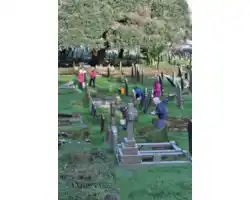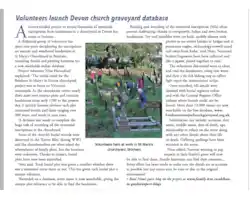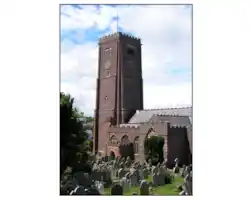Project volunteer Nina Hannaford spotlights a lottery funded project to record the memorial inscriptions engraved on the headstones of those buried in St Mary's Churchyard in Brixham, Devon, which has come to fruition.
A dedicated group of volunteers have spent 2 years deciphering ancient and weathered headstones aiming to read the inscriptions, record the details and plot the locations.
The initial remit for the project was to focus on the Victorian memorials. As the Churchyard covers nearly 3 acres over various plots and contains headstones from early 1700 to the present day, it quickly became obvious each plot contained burials and dates ranging over 300 years, and rarely in neat rows.
A decision was made to complete the huge task of recording all the memorial inscriptions in the churchyard.
A huge task
During the Second World War some of St Mary's Churchyard records were destroyed in the ‘Exeter Blitz’. The Churchwardens are frequently asked the whereabouts of family plots recorded in the Church burial records, but the actual locations were unknown.
The Church and Churchyard were divided into 12 different areas, each given a number. Each row of headstones were given an alphabetical reference but as few rows are straight, some estimation was required.
Each burial plot was then given a number, whether there was a memorial stone there or not. This has given each burial plot a unique reference.
Recorded on a database, every name is now searchable, giving the unique plot reference to be able to find the headstone.
Project challenges
The reading and recording of the memorial inscriptions presented many problems. Some headstones and tombs of slate, granite and limestone were neglected and overgrown with ivy and lichens. A number had been broken and only fragments remained.
Ivy and brambles were cut back, mobile phones took photos to see stones hidden in hedges and at precarious angles, archaeology trowels eased turf away from kerbs. Scattered broken fragments have been collected and like a jigsaw, placed together to read.
As time went on, volunteers found that reading the headstone details was very much dependant on available light at different times of day. The stones, once cleared of overgrowth, would be rinsed with rain water.
It was discovered that by using a tin foil ‘baking tray’, reflected light was played upon the stone mason’s script, revealing previously illegible wording. A further problem that figures 3,5 and 8 along with 1 and 4 can be difficult to distinguish.
Having recorded the memorial inscriptions 'in the field' the details were then checked with burial registers made available online from various sources and with the General Registry Office lists where burials could not be found.
This lead to another problem. Sometimes the name spellings and dates were different to those recorded on the stones. A decision was made to record the memorial inscription details and make a side note of any differences.
All relevant information from the memorial inscriptions has been recorded where they exist:
- surname
- first name
- middle name
- date of death
- age
- relationship to others on the stone
- any other details about the person's life or death
Online genealogical sources such and census returns were used to confirm almost illegible inscriptions, a note is made where the information has come from registers rather than the actual stone.
Once all the headstones had been read, recorded, checked, returned to and checked again, the information was added to a speadsheet to create a full database of all the memorial inscriptions in St Mary's Churchyard.
There are over 13,000 names recorded. Rich, poor, young, old, war dead, sailors who died in far away places and at home, a Norwegian sailor who died in the Bay, Charlotte Dix, a former slave from Jamaica who married a wealthy Navy Captain and William Hodges, the official artist on Captain Cook's second voyage.
Anyone wanting to pay respects at their family's grave will now be able to find them and family historians can find their ancestors.
Where it is recorded, researchers should be able to search for those lost at sea, killed in action, died of cholera etc.
Every effort has been made to make sure the details are as accurate as possible but any errors may be ours or due to the original stone mason!
How do I find out more?
Details of all the memorial inscriptions and their locations are printed in a bound book and kept for prosperity in St Mary’s Church. A map of the site showing the plots is placed on the Lych Gate. Copies are also available for reference at Brixham Library and Museum, Torquay Library local studies and Devon Heritage Centre in Exeter.
A scale model of the church has been built and is on display in the church, along with a painting of a Victorian aerial view of Cowtown.
Online access to the searchable database will also be available through Devon Family History Society, and websites such as Genuki and St Mary's Churchyard website.
QUICK LINK: Video guide - how to use death certificates in family history











